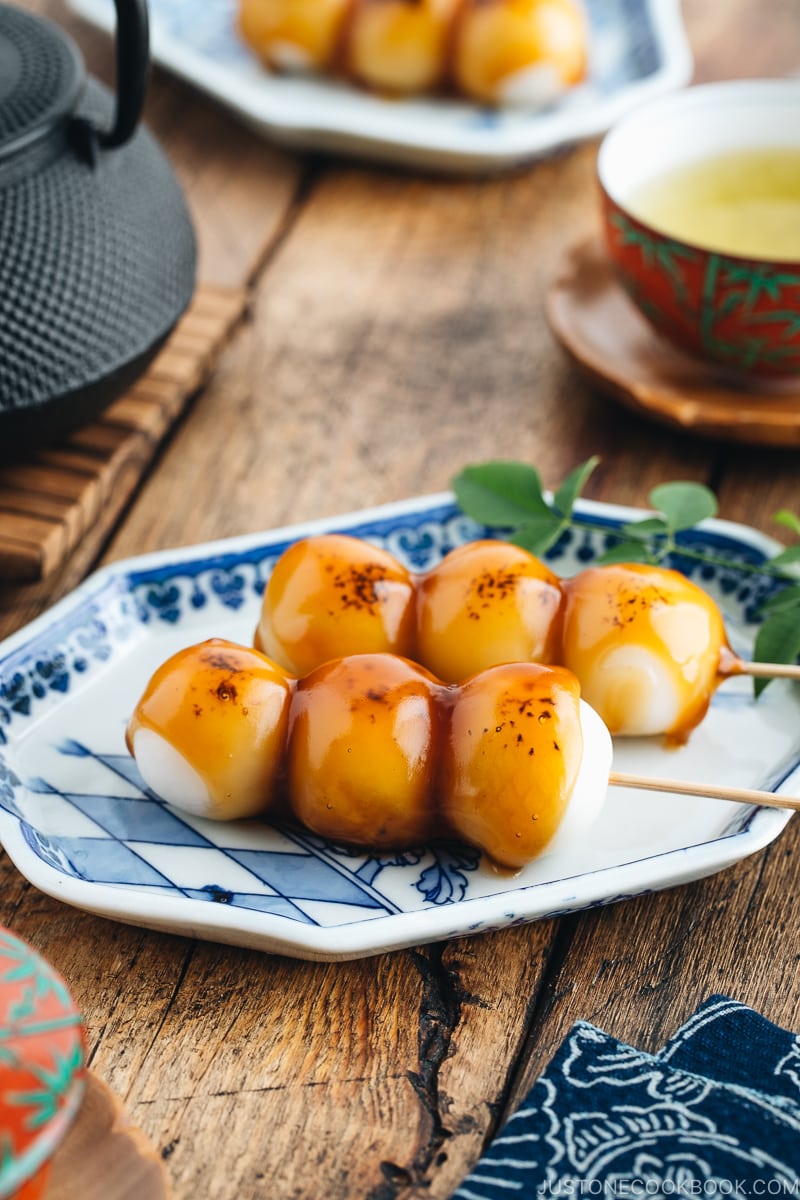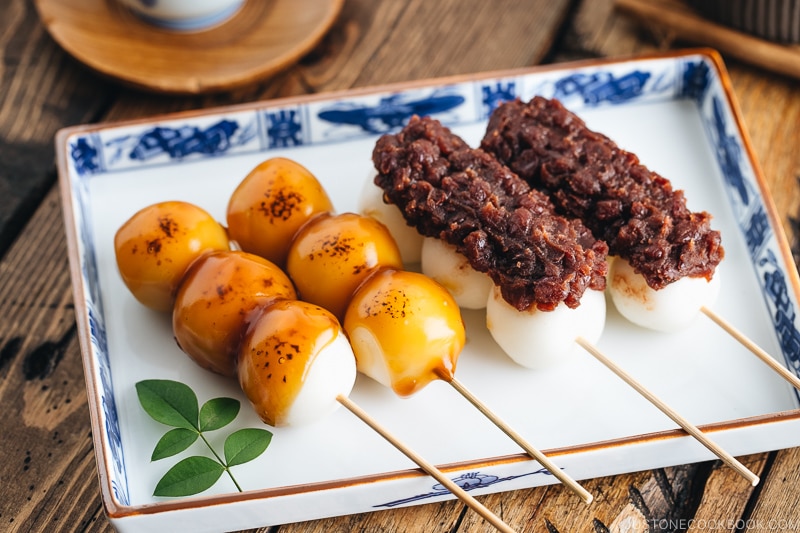
Mitarashi Dango (Mitarashi Dango) is a type of spacesweet rice dumplings, skewered onto a bamboo stick. Typically, three to five dumplings (traditionally five) are on a skewer and covered with a sweet soy sauce glaze.
It is fairly easy to make these dango at home. These chewy dumplings are mildly sweet and get a hint of char from grilling. When we brush the glaze over the dumplings, each bite is gooey, savory, and satisfying without being overly sweet. You’ll love the contrasting textures and flavors. They make a fun, delicious snack with a hot cup of green tea.
Also, check out my Hanami Dango and Shiratama Dango recipes!


Origin of Mitarashi Dango
Mitarashi dango originated from the Kamo Mitarashi Tea House in Kyoto. The dango was thought to be made as an offering for the gods, and the name was given after the bubbles of the mitarashi (御手洗), a font of purifying water placed at the entrance of a famous shrine in the city. Street vendors in Kyoto started selling dango as a snack, which quickly gained popularity among many visitors.
Today you can find mitarashi dango being sold at supermarkets, convenience stores, and specialty sweet shops all over Japan.
Ingredients for Mitarashi Dango
To make an authentic dango, you will need the following ingredients.
- A combination of joshinko and shiratamako (or from the instead) – I’ll discuss further on this topic below.
- Boiling water
- The delicious sweet and savory glaze – I am willow, sugar, mirin, potato starch (cornstarch)
How to Make Mitarashi Dango
The recipe card below guides you through with detailed instructions and step-by-step pictures, but here’s a quick summary.
- To make the dough: Combine the joshinko and shiratamako (or dangoko) with (hot) water. Knead the dough until combined. The dough should have a texture of our “earlobe” (yes, it’s a strange expression, but it’s commonly used when making wagashiJapanese sweets). Divide the dough and form into round dango balls.
- To cook the dango: Cook the dango balls in boiling water. Transfer to iced water and skewer 3 balls into each bamboo stick.
- Give a nice char: Use a kitchen torch or a frying pan to give dango a nice char. You can skip this process, but I think dumplings with a grilled mark look more delicious.
- To make the glaze: Combine the ingredients in a saucepan and cook the sauce until thickened.
- To serve: Drizzle the glaze on top of the dango. Serve immediately.
Learn about Japanese Glutinous Rice Flour and Rice Flour


To achieve the perfect texture for the dumplings, you need to use the following types of rice flour:
- Johshinko (上新粉) – a flour made from Japanese short-grain rice (uruchimai non-glutinous rice).
- Shiratamako (Shiratamako) – a flour made from Japanese short-grain glutinous rice (mochigome sticky rice).
I recommend an equal proportion: 50–50 ratio for both flours. The combination will give you the bouncy, chewy but not too sticky texture. If you like the chewy mochi-like texture, you can decrease joshinko to 40% and increase shiratamako to 60%.
But be careful not to increase the amount of shiratamako too much, as the dango will get too soft and the texture becomes more like shiratama dango. The mitarashi dango needs to be firmer than the shiratama dango.
When you go to a Japanese grocery store, you may find the third type of flour called from the (団子粉), a combination of rice flour and glutinous rice flour (the ratio is up to the manufacturer).
If you have trouble finding joshinko and shiratamako, dangoko might be your best option. The texture of dumplings made with dangoko is firmer and chewier.
Where to buy johshinko and shiratamako?
You can find shiratamako, joshinkoand from the on Amazon or at your local Japanese grocery stores. Some online Asian grocers may carry them.
Can I use mochiko in place of shiratamako and joshinko?
Although mochiko is similar to shiratamako, it’s produced differently. Mochiko yields a very soft and tender texture, which is unsuitable for dango. However, a reader has shared her experience of achieving good results by adding a spoonful of cornstarch to mochiko.
How about Thai glutinous rice flour?
Thai glutinous rice flour is not the same as Japanese glutinous rice flour, and it will not turn out right. To make the dango, you’ll need the flours I listed above.


FAQs
Q: Is it possible to make the dango a few hours ahead?
Sure, you can. However, if you like to keep the texture softer and tender for a longer time, you can add sugar to the flour at the start. The recommended amount of sugar is 20% of the flour’s weight, which is 40 grams.
If you plan on making the sauce ahead of time, remove it from the heat before the consistency gets too thick. The moisture will evaporate and thicken the sauce as it cools.
Q: If I make too much, can I store the leftover sweet soy sauce?
Yes. You may store it in the refrigerator for 2~3 days or freeze it. Reheat it in the microwave or heat it up in a pot to enjoy it again.
More Traditional Japanese Desserts & Sweets To Enjoy






Wish to learn more about Japanese cooking? Sign up for our free newsletter to receive cooking tips & recipe updates! And stay in touch with me on Facebook, Pinterest, YouTubeand Instagram.


Mitarashi Dango
Servings: 5 skewers (16–17 balls per batch)
Ingredients
For the Dumplings Using Joshinko and Shiratamako
For the Dumplings Using Dangoko
Prevent your screen from going dark
Instructions
-
Gather the ingredients for the dumplings. Joshinko (Joshinko) is flour made with Japanese short-grain rice and shiratamako (白玉粉) is flour made with short-grain glutinous rice; they are different from other Asian varieties. For more details, see Notes at the end of the recipe card. Joshinko and shiratamako are pictured on the left and from the (団子粉) is pictured on the right. Whichever you decide to use, the instructions below are the same.
-
Gather the ingredients for the sweet soy glaze. Soak the bamboo skewers in water. You can start boiling a large pot of water on low heat (see Step 8).
To Make the Rice Dumplings
-
Combine ⅔ cup joshinko (Japanese rice flour) and ¾ cup shiratamako (glutinous rice flour/sweet rice flour) in a bowl. Using chopsticks, mix it all together until well blended. (If you‘re making the dumplings using dangoko, add 1⅓ cup dangoko (Japanese rice dumpling flour) instead to a bowl.)
-
Stir in some of the ⅔ cup boiling water, a little bit at a timewhile mixing with chopsticks. Please note: You can always add more water so go with a small addition. The dough should be on the dry side.(Or, stir in some of the ⅔ cup water (cold) for the dangoko, a little bit at a time.)
-
When the flours start to stick together and eventually form clumps, stop adding water. Using your hands, combine the dough into one ball.
-
Knead until the dough becomes smooth. The texture is like squeezing an “earlobe“ (that’s how we describe the tenderness of this type of mochi in Japanese).
-
Form the dough into a ball. Divide the dough into 8 equal pieces.
-
Then divide each piece into 2 smaller pieces. You will have 16 equal-sized pieces of dough. I always like to weigh mine. Each ball should be 20 grams. You may have some extra dough, but that’s okay.
-
Shape each of the dough pieces into a smooth, round ball. If the dough is cracking or has some wrinkles, dip the tip of your finger in water and apply a small amount of water to the cracked area to smooth it out. You now have 16 equal-sized dumplings.
-
Just before cooking the dumplings, prepare a bowl of iced water. Once the water in the pot is boiling, gently drop each dumpling into the pot with a smooth, continuous arm motion to avoid splashing. Cook them all at once. Stir the balls occasionally so they keep their round shape and don‘t stick to the bottom of the pot.
-
The dumplings will stay near the bottom of the pot at first, but they will float once cooked. When they rise to the top, boil them for an additional 1–2 minutes.
-
Transfer the dumplings to the bowl of iced water.
-
Once the dumplings have cooled, drain them well and transfer them to a tray. Tip: Wet the tray so the dumplings don‘t stick.
-
Skewer three pieces onto a bamboo skewer. Continue with the rest of the dumplings and set aside.
To Make the Sweet Soy Glaze
To Store
-
Option 1: After you form the dough into round dumplings, you can store the uncooked dumplings in a single layer in an airtight container and freeze up to a month. When ready to use, boil the frozen dango without defrosting first.
-
Option 2: After boiling and cooling the dumplings, pat them dry and pack them so they don‘t touch each other into an airtight container. Freeze up to a month. When ready to use, microwave or boil them until warm.
Notes
To keep the Mitarashi Dango tender for a longer time: Adding sugar to the dango dough will help them stay softer. The recommended amount of sugar is 20% of flour’s weight (which is 40 grams). If you reduce the amount, it might not be as effective.
Nutrition
Nutrition Facts
Mitarashi Dango
Amount per Serving
% Daily Value*
* Percent Daily Values are based on a 2000 calorie diet.
©JustOneCookbook.com Content and photographs are copyright protected. Sharing of this recipe is both encouraged and appreciated. Copying and/or pasting full recipes to any website or social media is strictly prohibited. Please view my photo use policy here.
Editor’s Note: This post was originally published on May 14, 2012. It was republished with more helpful content, new images, and a new video on May 17, 2024.

